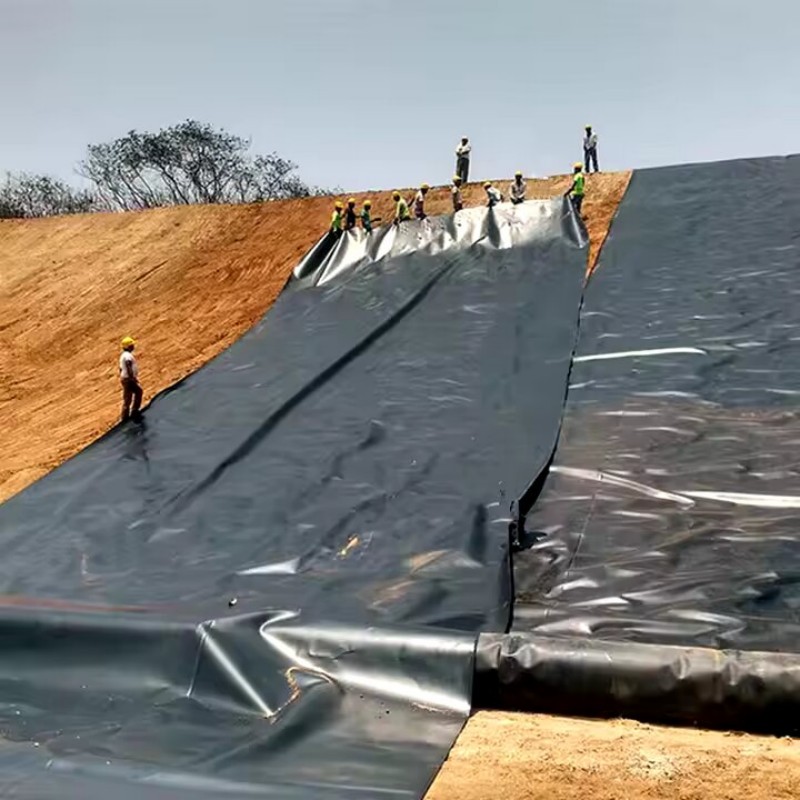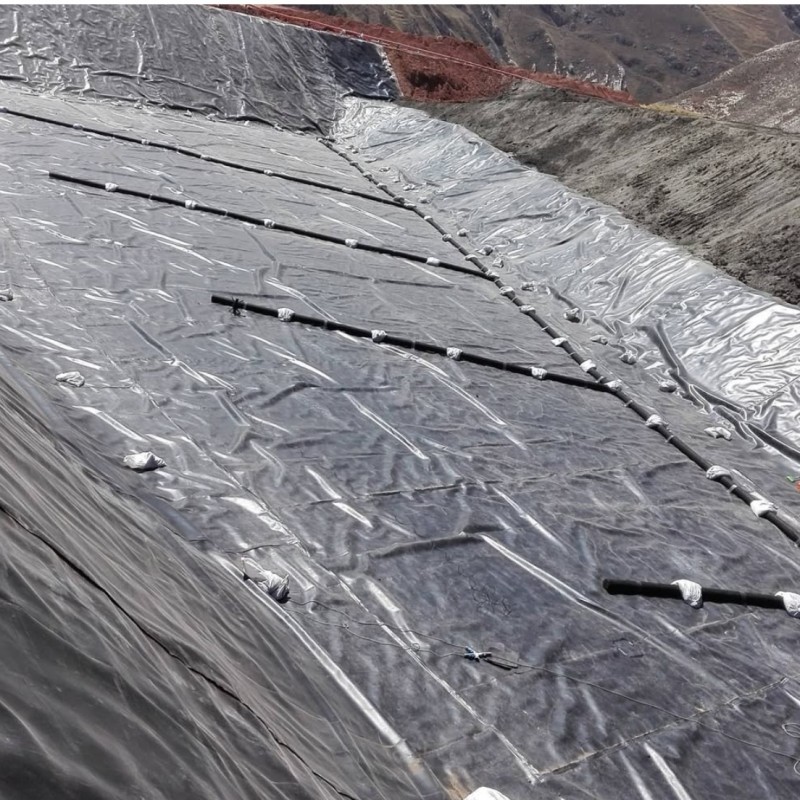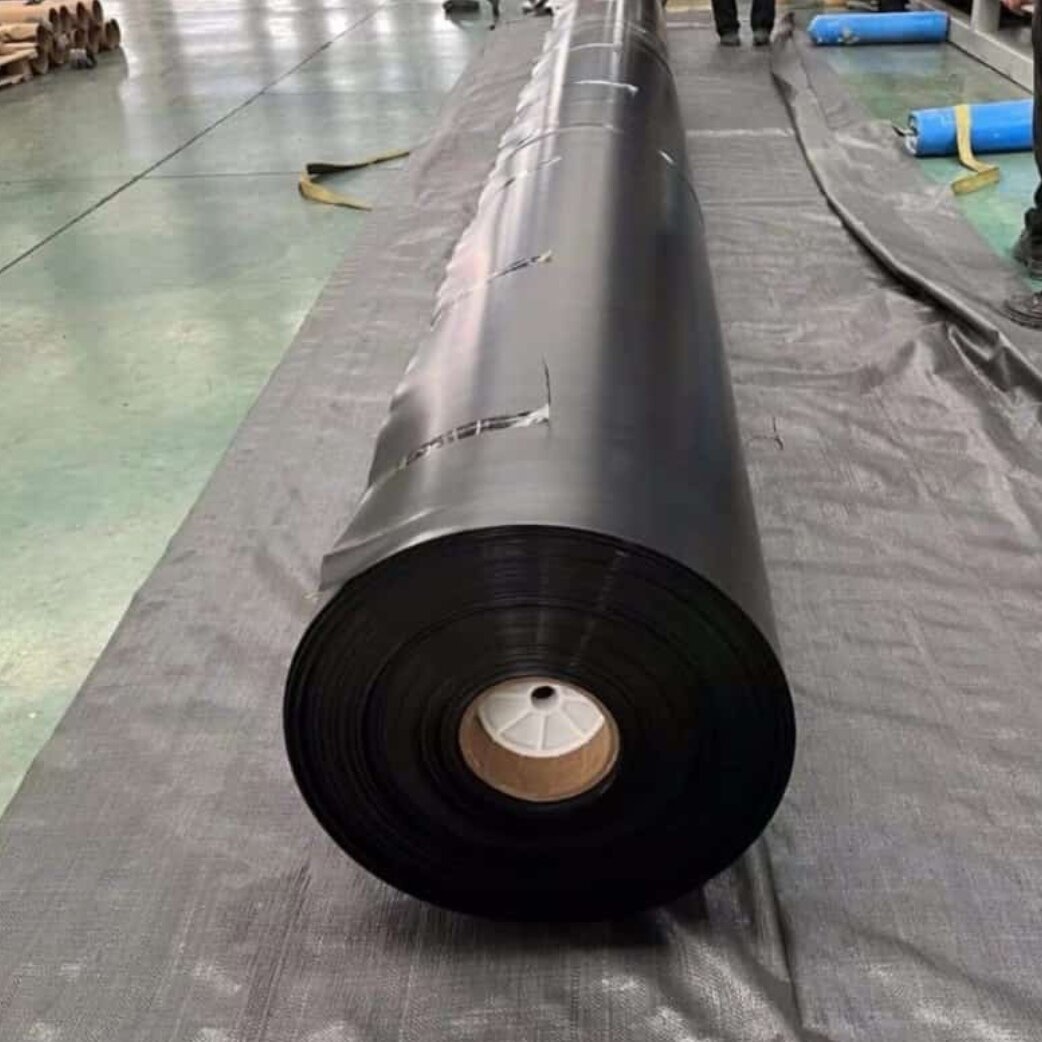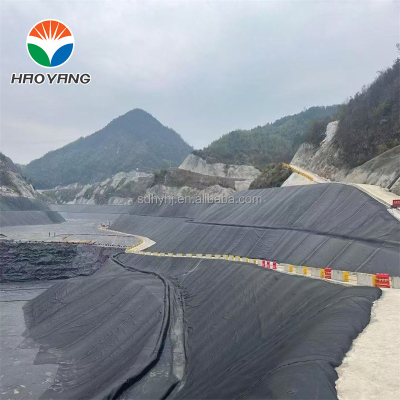Environmental Protection with HDPE Geomembrane Landfill Liner
1.Excellent Impermeability-Prevents leachate and gas leakage with ultra-low permeability, ensuring complete environmental protection.
2.High Chemical Resistance-Withstands acids, alkalis, and industrial waste liquids, making it ideal for harsh landfill conditions.
3.Superior Strength and Flexibility-The geomembrane HDPE 1.5 mm offers excellent tensile and puncture resistance for long-term stability.
4.UV and Aging Resistance-Performs reliably under sunlight and extreme temperatures, maintaining durability for over 50 years.
5.Easy Welding and Installation-Compatible with hot wedge and extrusion welding methods, ensuring secure seams and quick installation.
In the modern era of environmental awareness, protecting soil and groundwater from contamination is a global priority. Landfill construction—one of the most essential components of waste management—requires highly reliable waterproofing systems to prevent leachate leakage and toxic infiltration into the ecosystem. Among all available solutions, the HDPE landfill liner has become the industry standard due to its outstanding impermeability, durability, and chemical resistance.
1. What Is an HDPE Geomembrane Landfill Liner?
An HDPE geomembrane landfill liner is a synthetic barrier made from high-density polyethylene (HDPE), designed to contain waste materials and prevent pollutants from seeping into the soil or groundwater. It is typically placed at the base and sides of landfills to form a continuous impermeable layer.
The geomembrane liner landfill system usually consists of multiple protective layers—compacted clay, geotextiles, and HDPE geomembranes—working together to create a durable and leak-proof structure. Among these, the HDPE geomembrane serves as the most critical sealing component.
2. Why Choose HDPE Geomembrane for Landfills?
HDPE (High-Density Polyethylene) is a thermoplastic polymer known for its excellent resistance to chemicals, high tensile strength, and UV stability. These properties make it ideal for landfill and containment applications where environmental safety and long-term performance are required.
The HDPE landfill liner provides:
Outstanding impermeability to liquids and gases
Resistance to acids, alkalis, and organic solvents
Stability under extreme temperatures
Long service life exceeding 50 years under proper conditions
These characteristics ensure that the geomembrane liner landfill system effectively isolates hazardous waste and prevents environmental contamination.
3. The Importance of Geomembrane HDPE 1.5 mm Thickness
The geomembrane HDPE 1.5 mm specification is one of the most commonly used thicknesses in landfill engineering. It strikes an optimal balance between flexibility, mechanical strength, and cost efficiency.
Key performance features of 1.5 mm HDPE geomembrane include:
High Tensile Strength: With tensile values exceeding 25 MPa, it withstands heavy loads from waste compaction and movement.
Excellent Puncture Resistance: Protects against sharp debris and settlement stresses.
Easy Welding and Installation: Compatible with hot wedge and extrusion welding techniques, ensuring tight seams and minimal leakage risk.
Durability: Resistant to environmental stress cracking and UV degradation, suitable for both exposed and buried installations.
In large landfill projects, HDPE geomembrane 1.5 mm thickness ensures long-term protection with efficient installation and cost-effectiveness.
4. How HDPE Landfill Liners Protect the Environment
The primary function of an HDPE landfill liner is to contain leachate, a contaminated liquid generated from decomposing waste mixed with rainwater. Without proper lining, leachate can penetrate the ground, polluting aquifers and nearby ecosystems.
Geomembrane HDPE liners prevent this through the following mechanisms:
Impermeable Barrier: The HDPE liner’s extremely low permeability (<1×10⁻¹⁴ m/s) blocks liquid migration.
Chemical Isolation: Prevents hazardous substances such as heavy metals and organic compounds from interacting with soil and groundwater.
Gas Containment: Restrains methane and other gases generated in the landfill, allowing safe collection and reuse for energy.
Slope and Erosion Control: Maintains the structural stability of landfill slopes and prevents erosion caused by precipitation or runoff.
Through these functions, the geomembrane liner landfill system ensures environmental safety and regulatory compliance.
5. Applications of Geomembrane Liner Landfill Systems
HDPE geomembrane liners are widely used in various landfill applications, including:
Municipal Solid Waste Landfills (MSW): Prevent leachate infiltration and control odor and gas emissions.
Industrial Waste Landfills: Contain hazardous waste from manufacturing and mining activities.
Bioreactor Landfills: Facilitate leachate recirculation systems for waste stabilization while ensuring complete containment.
Capping and Closure Systems: Used as top liners to seal and rehabilitate closed landfill sites.
Beyond landfills, geomembrane HDPE liners are also applied in wastewater treatment plants, chemical containment areas, and tailing ponds, proving their versatility and effectiveness in multiple environmental projects.
6. Manufacturing and Quality Control
High-quality geomembrane HDPE 1.5 mm liners are manufactured using 100% virgin polyethylene resin with advanced extrusion and calendering technologies. The production process includes:
Automatic Thickness Control (ATC): Ensures uniform thickness and consistent mechanical properties.
Corona Surface Treatment: Improves weldability and adhesion.
Multi-Stage Testing: Includes tensile, tear, puncture, and oxidation resistance tests following ASTM and GRI GM13 standards.
Reliable HDPE landfill liner suppliers provide on-site technical support, welding equipment, and quality assurance documentation, ensuring seamless project execution.
7. Installation and Maintenance
Proper installation is essential to maintain the geomembrane’s long-term performance. Typical procedures include:
Preparing a smooth, compacted subgrade free of sharp stones or debris.
Unrolling the geomembrane in alignment with slope direction.
Welding seams using hot wedge or extrusion welding methods.
Conducting non-destructive seam testing (air pressure or vacuum testing).
Covering with protective layers such as geotextiles or sand before backfilling.
Routine inspection and monitoring are recommended to ensure the liner system remains intact throughout the landfill’s operational life.
8. Economic and Environmental Benefits
Investing in geomembrane HDPE 1.5 mm landfill liners not only enhances environmental protection but also reduces long-term operational costs. The material’s durability minimizes maintenance frequency and prevents costly environmental penalties.
Additionally, many landfill projects now integrate HDPE liners with gas collection systems, converting captured methane into renewable energy, contributing to carbon reduction and sustainable waste management.
No. | Item | Unit | Index | ||||||||
1 | Thickness | mm | 0.30 | 0.50 | 0.75 | 1.00 | 1.25 | 1.50 | 2.00 | 2.50 | 3.00 |
2 | Density | g/cm3 | ≧0.940 | ||||||||
3 | Tensile yield strength | N/mm | ≧4 | ≧7 | ≧10 | ≧13 | ≧16 | ≧20 | ≧26 | ≧33 | ≧40 |
4 | Tensile breaking strength | N/mm | ≧6 | ≧10 | ≧15 | ≧20 | ≧25 | ≧30 | ≧40 | ≧50 | ≧60 |
5 | Yield elongation | % | - | - | - | ≧11 | |||||
6 | Break Elongation | % | ≧600 | ||||||||
7 | Right-angle Tearing strength | N | ≧34 | ≧56 | ≧84 | ≧115 | ≧140 | ≧170 | ≧225 | ≧280 | ≧340 |
8 | Puncture strength | N | ≧72 | ≧120 | ≧180 | ≧240 | ≧300 | ≧360 | ≧480 | ≧600 | ≧720 |
9 | Carbon black content | % | 2.0~3.0 | ||||||||
10 | Dispersion of carbon black | - | There is not more than one level 3 in 10 data, and level 4 and level 5 are not allowed to exist. | ||||||||
11 | Oxidation induction time | min | ≧60 | ||||||||
12 | Low temperature impact embrittlement properties | - | Pass | ||||||||
13 | Water vapor permeability coefficient | g.cm/ (cm2.s.Pa) | ≦1.0*10-13 | ||||||||
14 | Dimensional stability | % | ±2.0
| ||||||||
Note | Technical performance indicators for thickness specifications not listed in the table are required to be performed by interpolation. | ||||||||||
The use of HDPE geomembrane landfill liners is a vital step toward sustainable environmental protection and responsible waste management. With superior impermeability, chemical resistance, and mechanical strength, geomembrane HDPE 1.5 mm provides a dependable barrier system for modern landfills.
Whether for new landfill construction or rehabilitation of existing sites, a geomembrane liner landfill system ensures long-term containment, ecological safety, and compliance with international environmental standards.
Selecting a reliable HDPE geomembrane manufacturer—offering certified materials, technical support, and on-site guidance—ensures your project’s success in both environmental and economic terms.












